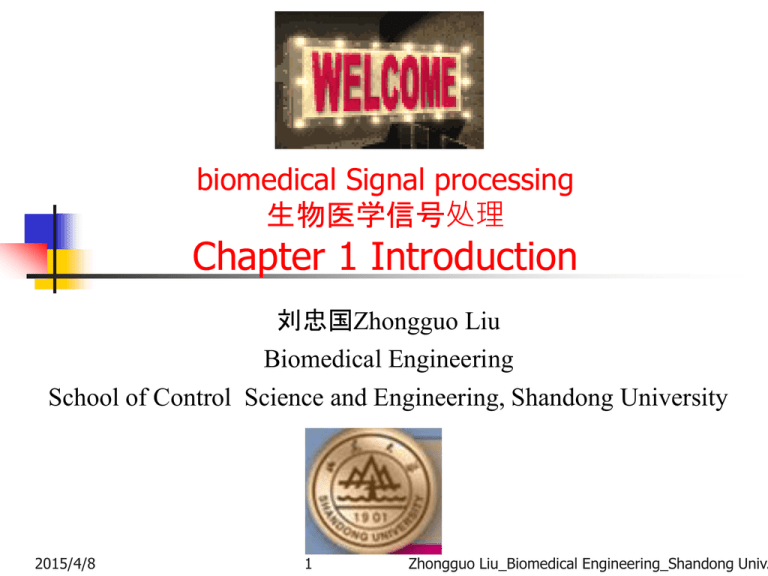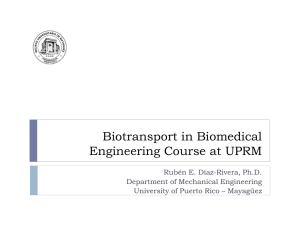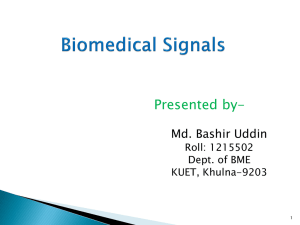Chapter1 Introduction
advertisement

biomedical Signal processing 生物医学信号处理 Chapter 1 Introduction 刘忠国Zhongguo Liu Biomedical Engineering School of Control Science and Engineering, Shandong University 2015/4/8 1 Zhongguo Liu_Biomedical Engineering_Shandong Univ. Self Introduction 刘忠国:liuzhg@sdu.edu.cn Tel:88384747 cellphone:18764171197 2 2015/4/8 Zhongguo Liu_Biomedical Engineering_Shandong Univ. Goals of the course • To understand – what biomedical signals are – what problems and needs are related to their acquisition and processing – what kind of methods are available and get an idea of how they are applied and to which kind of problems • To get to know basic digital signal processing and analysis techniques commonly applied to biomedical signals and to know to which kind of problems each method is suited for (and for which not) biomedical Signal Processing Signal: any physical quantity that varies as a function of an independent variable • independent variable is usually time but may be space, distance, ... Biomedical signal: a signal being obtained from a biologic system /originating from a physiologic process (human or animal (medical -> patients)) Processing of biomedical signals all treatment (of biomedical signals) which occurs between their origin in a physiological process and their interpretation by their observer (e.g. clinician) Processing of biomedical signals Processing of biomedical signals Processing of biomedical signals is application of signal processing methods on biomedical signals →All possible processing algorithms may be used →Biomedical signal processing requires understanding the needs (e.g. biomedical processes and clinical requirements) and selecting and applying suitable methods to meet these needs Rationales for biomedical signal processing 1.Acquisition and processing to extract a priori desired information 2.Interpreting the nature of a physiological process, based either on a) observation of a signal (explorative nature), or b) observation of how the process alters the characteristics of a signal (monitoring a change of a predefined characteristic) (Some) goals for biomedical signal processing • Quantification and compensation for the effects of measuring devices and noise on signal • Identification and separation of desired and unwanted components of a signal • Uncovering the nature of phenomena responsible for generating the signal on the basis of the analysis of the signal characteristics – Related to modelling / inverse modelling but often more pragmatic Example: heart rate meters Sensor Signal processing User Example: IST Vivago® WristCare Health monitoring Systolic and diastolic blood pressure Need for processing to draw any conclusions Beat-to-beat heart rate Signal processing methods Noise reduction Preprocessing Signal validation Feature extraction Data compression Segmentation Pattern recognition Trend detection Event detection Decision support Decision making Filtering (linear, nonlinear, adaptive, optimal) Statistical signal processing Frequency domain analysis Time-frequency analysis Fuzzy logic Artificial neural networks Expert systems, rule-based systems Genetic and evolutionary methods Signal processing methods Signal modelling Wavelets and filter banks PCA, ICA, SVD Clustering Higher-order statistics Chaos and nonlinear dynamics Complexity and fractals ∴ Choose right method for right problem! Biomedical signal classification On the basis of – signal characteristics: technical point of view – signal source: from where and how the signal is originated and measured – biomedical application: neurophysiology, cardiology, monitoring, diagnosis,… Classification may be helpful in the selection of processing methods... Definitions Deterministic: may be accurately described mathematically, Usually predictable (not in case of chaos!) Periodic: s(t)=s(t+nT) Almost periodic: patterns repeat with some unregularity Transient: signal characteristics change with time Definitions Stochastic: defined by their statistical properties (distribution) Stationary: statistical properties of the signal do not change over time Ergodic: statistical properties may be computed along time distributions (White noise: acf = 0 except for τ=0 where acf=1; flat spectrum) Definitions All real (bio)signals may be considered stochastic – almost deterministic signals (e.g. ECG): wave shapes that (almost) repeat themselves → characterization (often) by detection of certain measures or waves – “truly” stochastic (e.g. EEG) → characterization by statistical properties Classification by source • biomedical signals differ from other signals only in terms of the application signals that are used in the biomedical field • Bioelectric signals: generated by nerves cells and muscle cells. Single cell measurements (microelectrodes measure action potential) and ‘gross’ measurements (surface electrodes measure action of many cells in the vicinity) Classification by source • Biomagnetic signals: brain, heart, lungs produce extremely weak magnetic fields, this contains additional information to that obtained from bioelectric signals. Can be measured using SQUIDs. • Bioimpedance signals: tissue impedance reveals info about tissue composition, blood volume and distribution and more. Usually two electrodes to inject current and two to measure voltage drop Classification by source • Bioacoustic signals: many phenomena create acoustic noise. For example, flow of blood through the heart, its valves, or vessels and flow of air through upper and lower airways and lungs, but also digestive tract, joints and contraction of muscles. Record using microphones. • Biomechanical signals: motion and displacement signals, pressure, tension and flow signals. A variety of measurements (not always simple, often invasive measurements are needed). Classification by source • Biochemical signals: chemical measurements from living tissue or samples analyzed in a laboratory. For examples, ion concentrations or partial pressures (pO2 or pCO2) in blood. (low frequency signals, often actually DC signals) • Biooptical signals: blood oxygenation by measuring transmitted and backscattered light from a tissue, estimation of heart output by dye dilution. Fiberoptic technology. Biomedical application domains • Information gathering – measurement of phenomena to understand the system • Diagnosis – detection of malfunction, pathology, or abnormality • Monitoring – to obtain continuous or periodic information about the system Biomedical application domains • Therapy and control – modify the behaviour of the system and ensure the result • Evaluation – objective analysis: proof of performance, quality control, effect of treatment Problems in biomedical signal processing Accessibility – Patient safety, preference for noninvasiveness – Indirect measurements (variables of interest are not accessible) Variance – Inter-individual, intra-individual Problems in biomedical signal processing Inter-relationships and interactions among physiological system – Subsystem of interest may not be isolated Acquisition interference – Instrumentation and procedures modify the system or its state Artefacts and interference – Interference from other physiological systems (e.g. muscle artifacts in EEG recordings) – Low-level signals (e.g. microvolts in EEG) require very sensitive amplifiers; they are easily sensitive to interference, too! – Limited possibilities for shielding or other protection Nonlinearity and obscurity of the system under study Artefacts and interference – basically all biological systems exhibit nonlinearities while most of the methods are based on the assumption of linearity →approximation – exact structures and true function of many physiological systems are often not known Signal acquisition Short-term HRV and BPV signal processing Applications of signal processing: entertainment, communications, space exploration, medicine, archaeology(考 古学), etc. Driven by the convergence of communications, computers and signal processing. 34 2015/4/8 Zhongguo Liu_Biomedical Engineering_Shandong Univ. signal processing Signal processing is benefited from a close coupling between theory, application, and technologies for implementing signal processing systems. Signal processing is concerned with the representation, transformation, and manipulation of signals and the information they contain. 35 2015/4/8 Zhongguo Liu_Biomedical Engineering_Shandong Univ. Continuous and Digital Signal Processing Prior to 1960: continuous-time analog signal processing. Digital signal processing is caused by: the evolution of digital computers and microprocessors Important theoretical developments such as the fast Fourier transform algorithm (FFT) 36 2015/4/8 Zhongguo Liu_Biomedical Engineering_Shandong Univ. Digital and Discrete-time Signal Processing In digital signal processing Signals are represented by sequences of finite-precision numbers Processing is implemented using digital computation Digital signal processing is a special case of discrete-time signal processing 37 2015/4/8 Zhongguo Liu_Biomedical Engineering_Shandong Univ. Digital and Discrete-time Signal Processing Continuous-time signal processing: time and signal are continuous Discrete-time signal processing: time is discrete, signal is continuous Digital signal processing: time and signal are discrete 38 2015/4/8 Zhongguo Liu_Biomedical Engineering_Shandong Univ. Discrete-time Processing Discrete-time processing of continuous-time signal Real-time operation is often desirable: output is computed at the same rate at which the input is sampled 39 2015/4/8 Zhongguo Liu_Biomedical Engineering_Shandong Univ. Objects of Signal Processing Process one signal to obtain another signal Signal interpretation: Characterization of the input signal, Example: speech recognition speech digital preprocessing signal (filtering,parameter estimation,etc) pattern recognition final signal interpretation 40 2015/4/8 phonemic transcription exert system Zhongguo Liu_Biomedical Engineering_Shandong Univ. Objects of Signal Processing Symbolic manipulation of signal processing expression: signal and systems are represented and manipulated as abstract data objects, without explicitly evaluating the data sequence 41 2015/4/8 Zhongguo Liu_Biomedical Engineering_Shandong Univ. Why do We Learn DSP Software, such as Matlab, has many tools for signal processing It seems that it is not necessary to know the details of these algorithms, such as FFT A good understanding of the concepts of algorithms and principles is essential for intelligent use of the signal processing software tools 42 2015/4/8 Zhongguo Liu_Biomedical Engineering_Shandong Univ. Extension Multidimensional signal processing image processing Spectral Analysis Signal modeling Adaptive signal processing Specialized filter design Specialized algorithm for evaluation of Fourier transform Specialized filter structure Multirate signal processing Walet transform 43 2015/4/8 Zhongguo Liu_Biomedical Engineering_Shandong Univ. Historical Perspective 17th century The invention of calculus Scientist developed models of physical phenomena in terms of functions of continuous variable and differential equations Numerical technique is used to solve these equations Newton used finite-difference methods which are special cases of some discretetime systems 44 2015/4/8 Zhongguo Liu_Biomedical Engineering_Shandong Univ. Historical Perspective 18th century Mathematicians developed methods for numerical integration and interpolation of continuous functions Gauss (1805)discovered the fundamental principle of the Fast Fourier Transform (FFT) even before the publication(1822) of Fourier's treatise on harmonic series representation of function (proposed in 1807) 45 2015/4/8 Zhongguo Liu_Biomedical Engineering_Shandong Univ. Historical Perspective Early 1950s signal processing was done with analog system, implemented with electronics circuits or mechanical devices.first uses of digital computers in digital signal processing was in oil prospecting. Simulate signal processing system on a digital computer before implementing it in analog hardware, ex. vocoder 46 2015/4/8 Zhongguo Liu_Biomedical Engineering_Shandong Univ. Historical Perspective With flexibility the digital computer was used to approximate, or simulate, an analog signal processing system The digital signal processing could not be done in real time Speed, cost, and size are three of the important factors of the use of analog components. Some digital flexible algorithm had no counterpart in analog signal processing, impractical. all-digital implementation tempting 47 2015/4/8 Zhongguo Liu_Biomedical Engineering_Shandong Univ. Historical Perspective FFT discovered by Cooley and Tukey in 1965 an efficient algorithm for computation of Fourier transforms, which reduce the computing time by orders of magnitude. FFT might be implemented in specialpurpose digital hardware Many impractical signal processing algorithms became to be practical 48 2015/4/8 Zhongguo Liu_Biomedical Engineering_Shandong Univ. Historical Perspective FFT is an inherently discrete-time concept. FFT stimulated a reformulation of many signal processing concepts and algorithms in terms of discrete-time mathematics, which formed an exact set of relationships in the discrete-time domain, so there emerged a field of discrete-time signal processing. 49 2015/4/8 Zhongguo Liu_Biomedical Engineering_Shandong Univ. Historical Perspective The invention and proliferation of the microprocessor paved the way for low-cost implementations of discrete-time signal processing systems The mid-1980s, IC technology permitted the implementation of very fast fixed-point and floating-point microcomputer. The architectures of these microprocessor are specially designed for implementing discrete-time signal processing algorithm, named as Digital Signal Processors(DSP). 50 2015/4/8 Zhongguo Liu_Biomedical Engineering_Shandong Univ.








